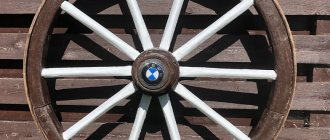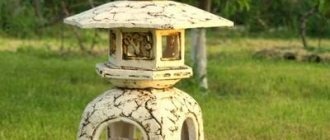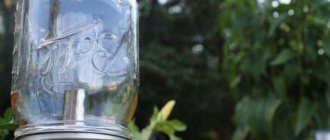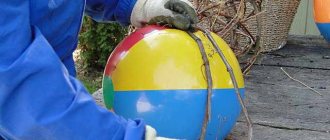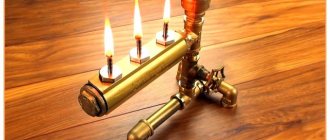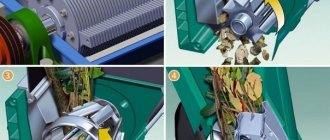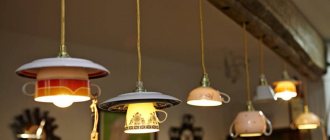Today, purchasing a landscape lantern is quite simple; the market is saturated with offers and amazes with the uniqueness of their shapes and sizes.
But economical, highly reliable lighting devices have a fairly high cost and therefore not every owner is able to purchase the required quantity on the market to illuminate the entire local area.
Therefore, many home craftsmen make LED lighting with their own hands. How to choose the right design for self-production, purchase consumables and assemble an electrical circuit, all about this in this article.
Is it possible to make a park lantern yourself?
A garden lamp is not structurally complex; it can be made with your own hands , either from scrap materials or from parts purchased in a retail chain. To do this, you will need a schematic and electrical diagram of the device, experience with the tool and knowledge of simple electrical circuits.
Lamps for landscape lighting work outdoors throughout the year, in hot weather, in cold weather, and in rain and snow. Therefore, it must be made with protection from moisture and dust of at least IP 64 -65, especially at the junction of electrical contacts, so that the electrical wiring does not short out in a humid environment.
Before starting work on the production of landscape lighting on the site on your own, you will need to evaluate the following parameters :
- Select the type of lamp: LED, halogen or regular incandescent lamp.
- Develop a power supply diagram for lanterns.
- Draw a plan for the location of lamps, determine their number.
- Choose a structure that will hold the lamps.
- Select the power type: 220 or 12 V, from the electrical network or battery.
What types of outdoor lamps are available for manufacturing?
At home, you can make quite a few types of landscape lamps, from the simplest in the form of an incandescent light bulb and a lampshade to LED automatic lamps with a long range, operating automatically from motion and light sensors.
The preferred options for making your own landscape lamp are:
The light source is an LED lamp, the most modern energy-saving model, which provides a high level of luminous flux and saves electricity, since it consumes 2-3 times less than halogen lamps.- Functionality – automatic switching on based on a signal from a motion or light sensor.
- Power options are non-volatile from solar panels and batteries and energy-dependent from a 220 V household network.
- Technical lighting – for illuminating roads, gates, stairs and parking lots.
- Decorative – for illuminating bushes, gazebos, pools or ponds.
- Accented – illumination of the facade of the house.
- Accompanying lighting and running lights along the path, luminaires react to movement with built-in motion sensors.
- Mechanical protection – high-strength glass and metal case.
- Mounting method - support, bracket and wall type.
- The type of lantern is landscape, floor lamp or façade.
- LED lighting power is 5-50 W, depending on the lighting area.
Assemble the body
1. Cut out the glass for the three walls and the door (Fig. 2 and “Detailed view”). Cover the glass on both sides with masking tape. Apply glue to the tenons of the two body crossbars (C). Assemble the crossbars and two posts (B) by inserting a piece of glass into the tongues (Fig. 5). Align the crossbars with the tenon shoulders on the posts.
2 Apply glue to two more crossbars, add glass, a front post and glue these parts to the previously assembled back wall (photo P). In the same way, assemble the remaining crossbars, glass and front pillar. Make sure the bottom and cover (A) fit easily onto the studs of the posts.
3. Assemble the door by gluing the posts (D) to the crossbars (E) and inserting the glass into place.
4. Finish all parts with 220 sandpaper.
5. Glue the lid and bottom to the body.
6. Drill holes in the tenons (photo E) and insert round dowels into them. Apply a clear coat (we used a nitro varnish in an aerosol can, spraying it three times).
Materials for landscape lighting in the country
These outdoor lights can be made from a wide variety of materials, many of which can be found around the home. The most popular materials at hand that are used to make landscape lamps with your own hands:
- Glass and plastic products: bottles, jars and other glass vessels, any are suitable. With this type, it is very important to choose a special light bulb with a high level of light dispersion. An unusual design for a glass lantern will be to cover its walls with patterns of special luminescent paint.
The coating will accumulate solar energy throughout the day and create a very attractive glow in the evening. Advantages: low costs and a wide variety of shapes. Disadvantages: low dispersion and high fragility.
- Tin cans with patterns over the entire area, it is better to paint the inner surface with a white background, and the outer surface is covered in a tone that matches the landscape design. Advantages: low costs, high design characteristics, variety of shapes. Disadvantages: low strength and durability, low anti-corrosion characteristics.
- Lanterns made of wood or wooden rods, which are assembled into a certain shape, such as a ball. Advantages: simple production, special appearance, you can use scrap materials, low costs. Disadvantages: massive structure, they are afraid of a humid environment, require special antiseptic treatment.
- Silumin is an aluminum alloy, molded and powder coated. Advantages: light weight, various shapes, low cost. Disadvantages: high fragility in the cold and a tendency to damage in an aggressive environment, for example, when salt and fertilizers come into contact with them.
- Metal the most reliable material for street lamps, especially for poles, fasteners and lamp housings. It is better to use for these purposes: cast iron, copper, steel and brass. The techniques used to process metals are welding, bending, forging and cutting.
Advantages: durability, many different shapes, resistance to mechanical damage and climatic influences. Disadvantages: high price, heavy weight, need for a foundation, susceptibility to corrosion if the external coating is damaged.
Where it all started
I wanted to arrange a romantic evening for my husband, bought some scented candles, but only then discovered that there was nowhere to put them. I had to be smart. After surfing various forums, I came across an interesting post about how a woman made lanterns from old tin cans. Judging by the photo, the homemade product turned out to be very attractive, so I decided to repeat it.
I also didn’t want to waste money on expensive flashlights. And making something with your own hands is a good way to exercise your imagination.
Rules for choosing lamps for the garden
The quality and cost of lighting depend on the type of lamps that will be installed in landscape lamps. Acceptable modifications of lamps that can be used for this type of street lamps:
Regular incandescent lamps. Advantages: low purchase price, availability in retail chains, continuous emission spectrum, “warm” color tones.
Disadvantages: low level of color rendering, high costs of electricity for lamp operation, high heat transfer rate.- Halogen light bulbs . Advantages: more economical, longer service life, stable luminous flux, smaller external dimensions, high thermal and mechanical resistance characteristics, high power, lower power consumption to operate the lamp. Disadvantages: you need a transformer for operation, sensitivity to voltage changes, strong heating, which requires the use of heat-resistant materials for the lamp and housing.
- LED lamps – the most popular devices for landscape lighting. Advantages: very economical, do not contain harmful substances, high level of color rendering, can be used for lamps made of any materials, even paper, long service life up to 100,000 hours, belong to low-voltage equipment, and therefore have an increased degree of safety.
Disadvantages: susceptible to power surges, high price, emit uneven light.
According to all characteristics, the best option for street lighting of the local area is LED lamps.
DIY garden street lamp
Beautiful lighting plays an important role in the design of a summer cottage. A high-quality lighting system allows you to admire your garden not only during the day, but also in the evening. Moreover, properly designed lighting can transform an evening garden beyond recognition. Of course, you can purchase a street lamp in a store. Fortunately, there is plenty to choose from: the trade offers a huge assortment in different price categories. But making an exclusive street lamp with your own skilled hands is not at all difficult.
Selecting a Power Source
For landscape lighting, a 220 V household power supply is used, autonomously powered by rechargeable batteries or solar panels. Unlike a traditional incandescent lamp, an LED lamp can only be powered by direct current.
To operate them, you will need a special current source that produces a constant voltage at the output. All power supplies differ in the type of assembly and voltage conversion option.
They are divided into the following groups:
Transformer .
The composition includes: transformer, filter, rectifier and stabilizer. Advantages: simple installation, withstand idle function. Disadvantages are vulnerable to overload and carry a lot of weight.- Pulse . Advantages: light weight, compact and able to work with increased impulses. Disadvantages: they do not tolerate idling and overload conditions well.
- Driver . Rectifies stabilized current, capable of operating at frequencies of 30-50 Hz. Wide range of output parameters adjustment.
There are 3 options for connecting the LED lamp to a 220 V household network :
- Consistently. When all the lamps are connected with one wire, a phase is applied to the beginning, and zero is applied to its end. The advantage is low installation costs. The disadvantage is that if one lamp fails, the entire lighting line will not work.
- Parallel. Each lamp is connected to a phase and a neutral or grounding. The advantage is the high efficiency of the circuit, even if one or more lamps fail. The disadvantage is the high consumption of wires for connection.
- A beam circuit is a particular type of parallel system, when the sources are installed around the perimeter, 2 or 3 grounded wires are supplied to each lamp.
Thus, for LED lighting in the local area, the best effective constant current source is considered to be a 220 V household network, with a parallel circuit for connecting lamps, with the installation of a driver for rectifying the current.
To illuminate objects on the site, non-volatile LED lamps powered by solar batteries or batteries can also be used.
How to make neat folds
For straight and clear folds along the lines of the template, make a simple sheet bender. First, cut three square plates of about 100x100mm in size from scraps of 19mm plywood (the harder the material, the sharper the corners will be; we used birch plywood).
Insert the workpiece with the glued template between the two plates, aligning line A with the top edge, and clamp in a vice (left photo). Using the third plate, bend the free part of the workpiece down, pressing it evenly along the entire fold line. Then secure the workpiece between the plates along line B and do the same (middle photo).
To bend the two remaining walls of the pallet, cut a piece that fits snugly between the two finished walls (approximately 64x64 mm). Secure it between lines C and D using a small clamp and bend the remaining edges up. Then squeeze the piece in a vise to complete the bend of these walls (right photo).
Source
Diagram and photo of the design
Before making a landscape lamp, you will need to develop a design diagram of the garden lamp itself, an electrical circuit for powering the lamps and a plan for installing devices on the territory.
The composition of the latest documents will depend on the area that needs to be illuminated and the landscape project. These indicators determine the type of lamps, their power and quantity, as well as the volume of consumables :
- wires;
- cable;
- switching equipment;
- automatic start sensors;
- automatic protection of power lines from voltage overload in the network.
The first document, a design diagram of a garden lamp, determines the appearance of the lighting device, the specification of its parts and the assembly procedure.
For example, to produce a metal lantern in an antique style, the design diagram will look like this:
In order to make such a lantern with your own hands according to the diagram, you need to make 4 side walls, a top cover and a bottom, cut out glass for the sides, preferably with matte patterns. Decorative finishing of metal parts can be painted with regular paint or with imitation of antiquity.
The assembly of metal parts is carried out by cold welding. Next, the side windows and cartridge are inserted. After assembling the housing, begin connecting the power supply.
The assembly of the electrical power supply circuit from a 220 V household network must be carried out by a specialist with the appropriate electrical safety clearance group, so if the home craftsman does not have such qualifications, you need to invite an electrician for this work.
To lay the power line, it is better to choose an underground option, then hanging wires around the site will not spoil the landscape project.
You will first need to purchase a two-core copper electrical cable VVG with 1.5 mm2 conductors along the length of the laying determined according to the power supply diagram for lighting fixtures on the site, a corrugated pipe or metal hose D from 18 to 25 mm to protect the cable from rodents and terminal blocks with drain load 5 -10 A to ensure reliable electrical connections.
With an underground power supply circuit for landscape lighting, the owner of the house must save the executive circuit for future construction and excavation work on the local area.
To lay the cable, dig a trench at least 70 cm deep , with a distance from objects on the site of at least 60 cm. For floor lamps, you will need to install supports, which can be steel pipes, including used ones. In this option, they are thoroughly cleaned of corrosion products and treated with protective compounds.
Then a cable with leads sufficient to connect a 10-15 cm lamp is pulled through them. After this, the cable is placed in a corrugated sleeve with a 15 cm exit to the outside. The second piece of cable from the trench in the corrugated pipe is connected to the cable in the support using terminals.
If the lantern is of a wall type, then the connection is made through junction boxes. All contacts must be securely soldered, insulated and hidden in the box.
Assemble the connection diagram for the lighting device in such a way as to exclude the possibility of electric shock.
The connection point can be a simple protected outlet or terminals on an electrical panel .
After assembling the power supply circuit, it is checked for functionality and the wires are covered. If the circuit is assembled incorrectly, the LED lamp will not light up or will “blink”.
How to make a lamp from cotton wool in the shape of a cloud
Shot: @TiffyQuake / YouTube
What do you need
- Several paper lanterns of different sizes;
- glue gun;
- cotton wool;
- fishing line;
- wooden stick;
- hooks;
- garland.
How to do
Cover one lantern with a large amount of cotton wool.
Shot: @TiffyQuake / YouTube
Hang a wooden stick from hooks in the ceiling. This can be done using fishing line or thin rope. Tie another piece of fishing line to the base of the flashlight.
Shot: @TiffyQuake / YouTube
Hang the flashlight by a fishing line from a stick.
Shot: @TiffyQuake / YouTube
Cover the rest of the lanterns with cotton. Hang them from a stick to form a cloud. Fasten the parts together with glue.
Shot: @TiffyQuake / YouTube
Insert a garland into the lanterns. You can make it hang down from the cloud.
What other options are there?
You can also use cotton wool to cover plastic bottles with garlands:
Or balloons:
Step-by-step instructions for creating
To select the type and materials for making landscape lamps, you can use DIY projects , which are presented on the pages of online publications and have detailed instructions. Most often, such crafts are made from ready-made wooden, metal or plastic objects. For example, you can use ordinary wooden hangers for this.
Made of wood
A very stylish lantern can be made from pieces of edged board . To do this, it is sawn into five identical parts, 20 cm long. A rhombus is cut out in the center of all the boards. Using a drill and a drill bit D = 8 mm, cut out 4 holes at the same distance from each other. For the base you will need a circle and an equilateral pentagon.
In order to give a beautiful appearance to a wooden lantern, the outer surface is fired with a gas burner and then brushed on the annealed surface with a metal brush. As a result, all defects and irregularities are removed from the wooden surface, and the lamp acquires a warm brown color.
The manufactured parts of the landscape lantern are assembled, the circle is fixed on the pentagon, the side parts are attached to it with small nails, these parts are tied with a rope “crosswise”, so that the knots remain inside.
A hole for an 8 mm cable is drilled through the center of the circle and pentagon.
To attach the flashlight handle, drill two holes from the end of the circle with a 4 mm drill. The handle is made from a piece of rigid wire , giving it an elegant shape, the socket and lamp are installed, the body and electrical circuit are assembled, and the operation of the finished product is tested.
For such a lamp design, it is necessary to decorate the cable so that it does not spoil the “antique” look of the lamp with its modern look; for this, the cable is wrapped with twine and secured with a glue gun. The lamp is powered from a 220 V home network from a separate circuit breaker in the electrical panel.
LED Strip Light
You can easily make an unusual landscape lamp in the form of a flowing light stream from an old teapot yourself using an LED strip.
This lamp is energy efficient and
consumes little electrical energy, so it can be powered by solar panels and made portable for installation in any part of the garden or recreation area in the local area.
To form a jet, the ICE cord is folded in half, and a bundle of such cords is secured inside the kettle. To do this, insert a metal washer into the spout and thread a cord through it. They assemble a circuit powered by a solar battery, which can be bought in a retail chain or taken from a faulty lamp.
A drop
If you install a glass flask, which is used for watering flowers, on an old water tap, you can get a unique lamp in the shape of an amazing drop of light.
In order for the flask to be filled with uniform light,
the LED strip is wrapped around the wire and filled with a glass vessel .
The tape can be purchased with a control panel and a unit, which will allow you to choose colors and shades of lighting, creating an extravaganza of color, bringing a unique style and novelty to the landscape design of the site. The lamp can be powered from a 220 V network, batteries, solar or conventional batteries.
Made of plastic
This outdoor LED lamp is made from ordinary disposable white plastic spoons. For the base, a 5-liter plastic container with the bottom cut off was used.
The handles are broken off from the spoon, and the remaining parts are fixed to the base with an imitation of pineapple peel using a glue gun.
For this model of a homemade lamp,
only a low-temperature LED bulb is suitable . The lamp can have either an independent power supply from batteries or be connected to a 220 V power supply with a special electrical circuit with a choke.
Paper lantern: classic version
To make a flashlight with a base in the middle you will need:
- 2 sheets of paper of any color (preferably double-sided). To make the lanterns completely original, use paper with a pattern for scrapbooking. The sizes of rectangular leaves should be different. One – 180*100, the other – 180*120;
- PVA glue stick and scissors.
The flashlight is very simple to make; even 3-4 year old children can handle it, if they already know how to handle scissors at least a little. But in this case, adults should always be with them for safety reasons. So what to do next?
- The larger leaf should be folded in half and cut into equal strips from the fold side. If this task has been entrusted to a child, then draw out the sheet for him in advance so that he can make even cuts. The cut lines should not reach the edge of the sheet by about 1 cm.
- Roll the second leaf into a tube and glue it. By the way, it’s better to make the tube out of cardboard. This will make the flashlight more durable.
- Unfold the cut sheet and, just like the first one, roll it into a tube, having first wrapped it around the first one. Glue both parts of the flashlight together. All actions are clearly visible in the photo below.
As an option, decorate such multi-colored lanterns with different sparkles, stars made of colored paper, snowflakes, and confetti. They are easy to make with a regular or figured hole punch.
There is another version of such a flashlight, which is even easier to manufacture. There the middle is not done at all. See for yourself.
This version of lanterns will look especially beautiful in a garland. But if you want to illuminate them, do not forget that such paper products should only be used with LED bulbs.
The smaller you take the height of the rectangle, the lower and thicker the flashlight itself will be. Thinner cut strips are more elegant, and the product itself is more airy.
If the strips were cut a little diagonally, we got another version of the classic New Year's lantern made of paper.
What happens if the inside of the decoration is also cut into strips? You will get another airy and beautiful version of the flashlight!
Possible difficulties and errors
Technically, making the lantern itself for landscape lighting does not seem difficult; for this it is permissible to use both new parts from the store and those that can be found in any household. To do this you just need to use your imagination.
Difficulties with landscape lighting are caused by power supply schemes, choice of power and number of lighting devices. All 220 V power lines are classified as dangerous, the calculation and installation of which can only be carried out by specialists.
The main mistakes that users make when installing landscape lighting:
- The power, type and number of lamps are incorrectly selected. The installation does not perform its lighting functions or is energy-consuming to operate.
- Violation of underground cable laying standards.
- The cable characteristics do not correspond to the connection power of lighting devices.
- There is no protective grounding and no automatic safety system in the electrical network.
- The connection of lighting devices is made using twists without the use of terminal blocks.
- The cable is laid in the ground without metal hoses.
- The incandescent lamp is hermetically sealed in the lamp; there is no ventilation to cool it.
Manufacturing procedure
- Clean jars and remove labels. Print or draw a template and attach it to the jar.
- Using a small nail, mark the points where you will drill the holes.
That's all, now you can put a candle inside the lantern - a romantic mood is guaranteed.
Pros and cons of homemade decorative light
For those who are planning to make landscape lighting with their own hands from scrap and store-bought consumables, the main advantage of the finished project will be its low cost, which can be either zero or several times less than that of a new landscape lamp.
In addition, a homemade economical lamp gives its owner the following advantages :
- lighting of the local area, gazebo or recreation area;
- realization of creative potential;
- creating a colorful landscape in the local area.
The disadvantages of this type of landscape lighting include the low protection of home-made structures from atmospheric and mechanical influences, since they are mostly made of wood, plastics and old metal forms.
To create more reliable waterproof metal lamps, you will need metalworking experience and special welding equipment.
What best decorates an autumn garden? Cool DIY garden lanterns
You can simply throw away old things, or you can give them new life. It is the manufacture of various useful and decorative items from such things that is a very fashionable trend today. After all, this helps to preserve nature and is an excellent way to save money.
You can make beautiful original decorative elements from the most unexpected things that we usually throw in the trash. Here are some ideas on how you can make lamps for your summer cottage and living space.
Average expenses
They can be zero, since to create them you can use improvised materials that are at the disposal of the home craftsman. In this case, the main costs may be for underground cable laying and hiring electrical installation personnel.
Average costs for creating a 4-arm landscape lantern “grater”, with laying an underground two-core copper cable 1.5 mm2 10 m long:
The cost of a 10 m cable is 75x10=750 rubles.- Corrugated pipe 10 m – 14x10=140 rub.
- Cable laying 10 m (without excavation work) – 120x10=1200 rub.
- Connection to a house panel with a protection system – 1,500 rubles.
- LED lamps E27 4 pcs. - 4x96=384 rub.
- Lamp sockets 4 pcs. – 4x62=248 rub.
- Wooden base (waste) – 0 rub.
- Graters 4 pcs. – 130 rub. x 4 = 520 rub.
- Fasteners – 50 rub.
- Household electric circuit breaker – 480 rubles.
- Total: 5272 rubles, including underground installation and in-house power supply circuit - 4120 rubles, lamp - 1152 rubles.
Make metal fittings
For metal parts, take soft copper sheets with a thickness of 1.6 and 0.7 mm, which can be easily processed with ordinary tools. They can be cut with roofing scissors, sawed using a jigsaw or band saw with a narrow blade with fine teeth. Processing thin metal on a jigsaw will be more successful if you first attach the metal with double-sided tape to a backing made from scrap plywood or hardboard. Lubricate the file from time to time when sawing a regular candle or a piece of paraffin. Finish the edges of the cut piece with a file or sandpaper.
For soldering we used a miniature gas torch, soft solder in the form of a 3mm wire and soldering flux. As with soldering copper pipes, flux improves the wetting of the molten solder into the metal, helping it flow between the hot copper parts.
1. Cut blanks for parts FI and K-M from copper sheets 1.6 and 0.7 mm thick. Make the pipe blank (G) 13 mm longer than indicated.
2. Make a paper copy of the template for the candle tray (F), attach it to a copper blank (Fig. 6) and cut along the outer contour.
3. Fold the edges at a 90° angle along fold lines A and B, then along lines C and D (read the Wizard's Tip below). Remove the paper template and solder the corners of the tray (photo F).
4. Make a 50mm hole in a piece of 19mm plywood to create a pipe shape (G). Bend the pipe blank around the hole saw, then cut off the excess to ensure a snug fit against the sides of the hole and solder the ends together (Photo G).
5. Copy the flange template (H) and attach it to the appropriate workpiece (Fig. 7). Drill 3mm holes and through them attach the workpiece with screws to a piece of board or plywood. Make a hole with a diameter of 50 mm in the center (photo H).
Corrosion of metal
Metal corrosion is one of the important factors affecting the product. Elements of artistic forging of metal should be treated with painting oils so that corrosion does not appear for a long time.
On more expensive products, a special metal cleaning machine is used before painting. Despite the cost of such work, this is one of the best means for cleaning metal from rust and corrosion.
If the budget allows for expensive metal cleaning work, then you can afford expensive painting. Typically, for such work, zinc-containing oils are used, which can penetrate the top layer of metal and prevent moisture from affecting it.
Purpose of forged products
Do-it-yourself artistic forging has firmly taken a leading position in the modern market. These products can be found not only on fences and gates, but also on beds in ordinary apartments. There are several types of products where forging is used most often:
- Gates.
- Fences.
- Lattices.
- Stairs.
- Gazebos, barbecues.
- Furniture and its accessories.
Due to such a great demand for forged products, one can’t help but wonder why people like elements of artistic forging so much. After all, metal is a cold, heavy material that is susceptible to corrosion in the environment. In contrast to these negative factors, there are many favorable ones:
- Durability.
- Exquisite beauty.
- Increased protective functions.
- Possibility of production according to any dimensions and sizes.
- Full possibility of imagination in manufacturing.
- Forged products combine well with other materials.
And this is not the entire list of advantages of forged elements. If we combine all the above expressions, then metal objects are durable, strong and very beautiful products.
Varieties of patterns
From volumetric rolled metal, blacksmiths create various designs, which include several components:
- Spiral. The diameter of the spiral sometimes decreases downwards and changes its direction to the opposite. The result is a very original pattern, in which the direction of the spiral is regulated by artistic design.
- Double-row spiral. The middle part has the largest diameter. This ornament is called “Chinese lantern”. To obtain such a pattern, large cross-section wire is used.
- Volute. The pattern has the shape of a curl, located in different directions. The volute has a unidirectional concavity, while the curls have one bending axis. When the curls are on both sides of the center of the workpiece, they speak of multidirectional volute.
- Cool. To form such an ornament, part of the rod is twisted around an axis. Twisting always occurs in one direction, since being in a plastic state, when twisted in different directions, the rod can collapse.
- Top. These details decorate window grilles, as well as various fences. The element is a small piece of rod, the end of which has a sharp edge. Several curls are attached to it.
https://youtube.com/watch?v=TPeIWRxpMmQ
Additional artistic forging parts are made from sheet metal. These include:
- Spatial spirals. The appearance is similar to an auger. The width of the spiral decreases in the direction of rotation. The part may have a relief appearance. To do this, artistic marks are made on the edges.
- Flat curl. The element is similar to the three-dimensional one, only a metal strip is used for manufacturing.
- Coinage. To obtain a pattern, spot processing of the flat surface of the part is carried out. The operation is performed on non-ferrous metal.
- Punching. A special stamp is pressed into the sheet. In this way, you can make a monogram, give the image a three-dimensional appearance, and also form an inscription.
- Headings. A bowl-shaped container is rolled up from the strip. It can have several forms depending on the pattern being created.
Calculation of wiring elements
The type of wiring also depends on the type of lighting. At this stage, it is necessary to determine the exact number of lamps, their type and power, the length and cross-section of the cable, as well as the power of circuit breakers and residual current devices (RCDs).
Considering that lighting devices are marked in Watts, and energy meters and fuses in Amperes, to select machines with a suitable load you need to recalculate these parameters yourself. The calculation formula here is quite simple.
- For a single-phase network: Watt = Ampere * Volt (P = I * U).
- For a three-phase network: Watt = √3 * Ampere * Volt (P = √3 * I * U).
If you plan to install LED lights, then you need to select a low-voltage cable for them, and also install a transformer at the main switchboard; it will convert the outgoing voltage during operation.

